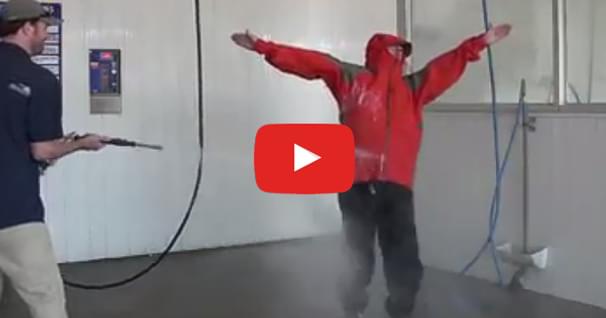Paddling Clothing for All Seasons
Proper paddling skills are extremely important, but they won't help you that much if you are not properly dressed for the conditions. Paddling is one activity where being voted "worse dressed" can make you late. Late, as in …the late (insert your name). So let's take a look at proper dress that will not only provide comfort, but can also save your life.
We'll work from the foundations on out, so let's start with the most benign condition:
Summer: Warm water and warm air make folks think of "shorts and t-shirt" weather. This is where fabrics provide protection from the sun as well as general comfort. We want quick drying fabrics that don't bind and provide some sun protection. Avoid cotton…it just doesn't do anything right when its wet and it will be wet. So swim suits, synthetic blend fast-dry shorts and shirts are the dress du jour for the warmest of conditions. Feet should get shod with water shoes or neoprene booties. Remember that footwear with straps (like sandals), laces or buckles could potentially get entangled in your footrests…this would be bad if you had to make a wet exit. Don't forget a brimmed hat with a chin strap to protect your head and help you keep your cool. Baseball style caps can work too, but remember that they usually expose your ears to sun, so slather on that sunscreen! Finish your summer ensemble with a quality sunglasses and you are ready for action. Note: polarized shades help you to see underwater obstructions more clearly as well as the various critters that may be swimming around in the shallows.
Spring/Fall: On both shoulders of summer, you'll find that you often need another layer to be comfortable. Check your dresser for an item leftover from ski season…synthetic long underwear such a polypropelene, cool-max or something similar make a terrific layer for cooler temperatures…no cotton. You'll need both tops and bottoms. If its even cooler, say the water temperature and the air temperature combined add up to be less than 100 degrees, you should consider adding a Farmer John/Jane style wetsuit to boost your warmth in the event of immersions. Add a paddling jacket to cut the wind and you'll stay both warmer and dryer. High topped neoprene booties keep your feet warm and the rubber soles provide protection carrying your boat to and from the water. In cooler weather you may consider a fleece hat or a neoprene hood to protect your head. After all, the entire goal of your body's circulatory system is to keep your brain warm; why not help it out?
Winter: Brrr. I migrate, but if you are one of the hearty souls that often ventures out when the water and air temperature combined are less than 70 degrees, then you may need to do more than layering everything above together. You're looking at dry suit conditions. Dry suits are designed simply to keep you dry with gaskets at your wrists, neck and ankles. You still need to add insulation underneath (all the stuff above). Some wise folks even wear a wetsuit under their drysuit in case of leakage. They are very expensive and often have custom options available like attached boots (great idea), a relief zipper or drop-seat (an even better idea) or breathable fabrics like Gore-tex. Though expensive, the breathable suits are far and away the most comfortable. Okay, big bucks, but what is your life worth? Remember, we are dressing for immersion. Feet get the neoprene bootie treatment with the addition of wool socks. It's tempting to wear rubber knee boots, but if they fill up in the water, you are compromising your odds greatly. The head gets a neoprene beanie and your hands will need protection from wind and cold. Pre-curved neoprene gloves, paddle mitts or pogies (a mitt that velcros around your paddle shaft allowing you direct contact) can all keep your fingers mobile and still allow you to grip your paddle.
Key points:
- Dress for the water temperature. If you have an untimely baptism you need to stay warm long enough to perform a rescue, whether assisted or self.
- Cotton kills. I can't stress this enough. Save it for when you are dry.
- Fabrics: Polypropelene, polar fleece, neoprene and fuzzy rubber are all excellent choices for paddlesports. The newer stretch fleece fabrics with the rubber coating on the outside (fuzzy rubber) are comfortable, quick drying and quite warm. They are much more comfortable to move around in than neoprene, but please take note that they are not quite as warm when you are exposed to prolonged immersion.
Michael Gray is director of Uncommon Adventures, specializing in kayak instruction and adventure tours since 1984. He has taught paddling technique in New Zealand, Belize, Honduras and all over North America. Uncommon Adventures can be found on the web at www.uncommonadv.com
Related Articles
This a follow up to a video I did where I talked about differences that you may find in dry and semi-dry…
Hi, I'm Kevin Callan and today on Body Gear we're gonna talk about rain gear. Rubber, it's not that bad…
Polytetrafluoroethylene, "hydrophilic monolithic laminates", oleophobic or perhaps even WVTRs…
"The tents weren't all that great, and I often slept under a canoe and would wrap my head in a towel to…


